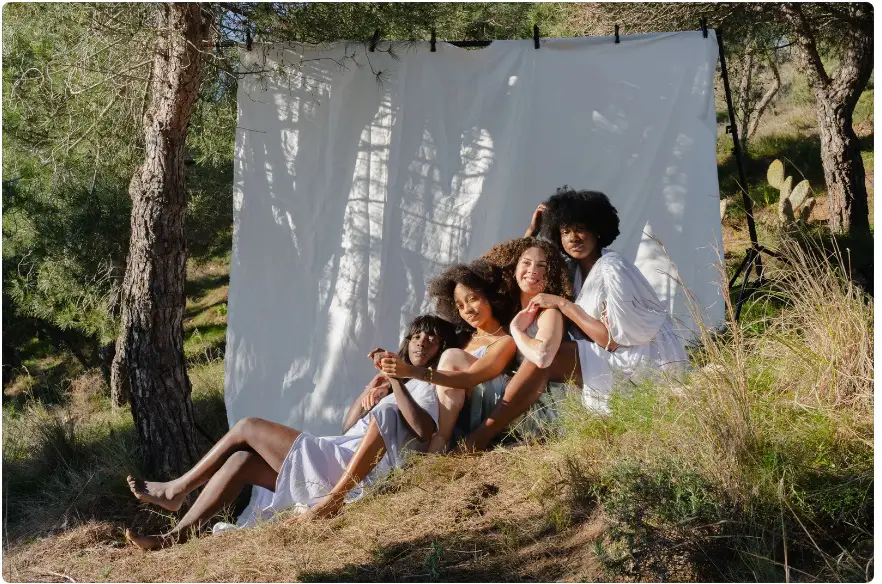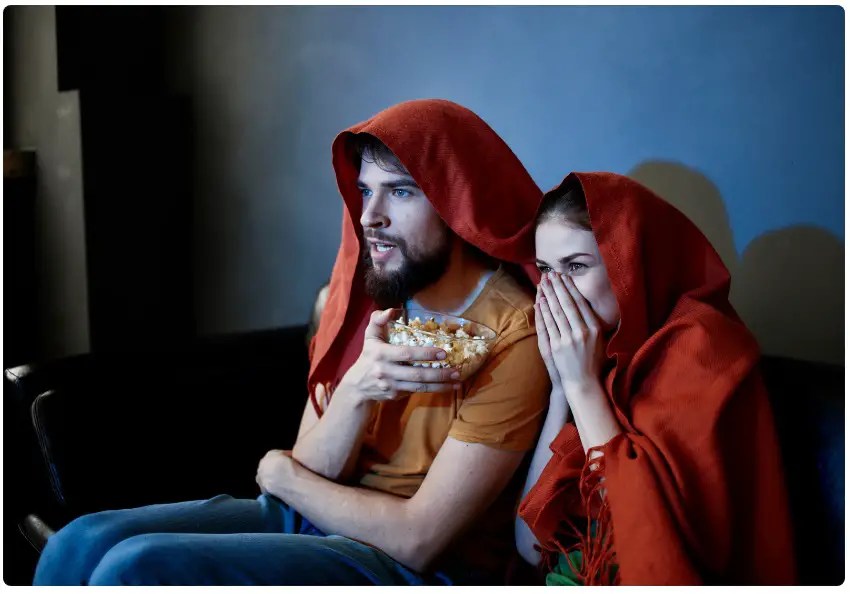Reality TV is a genre of television programming that focuses on real people and their experiences, as opposed to scripted shows. The rise of reality TV can be traced back to the 1940s, when Candid Camera first aired on television. However, it wasn’t until the 1990s that reality TV truly took off with the debut of shows like The Real World and Survivor.
The success of these early reality shows paved the way for many more to follow, including popular shows like American Idol, The Bachelor, and Keeping Up With The Kardashians. Today, reality TV is a staple in mainstream media and continues to captivate audiences worldwide.
Contents
Defining Reality Television Shows
While there are many different types of reality TV shows, they all share some common characteristics. These programs aim to portray “real life” situations or events through unscripted footage captured by cameras or other recording devices. Reality TV can also be categorized into sub-genres such as competition shows (e.g., Survivor), dating shows (e.g., Love Island), docu-series (e.g., Keeping Up With The Kardashians), and social experiment shows (e.g., Big Brother).
One defining characteristic shared by most reality TV programs is the use of confessionals or interviews with cast members. These segments give viewers insight into what contestants are thinking or feeling about certain situations or other cast members.
Despite their popularity among audiences, some critics have raised concerns about the authenticity of these programs. Some argue that producers manipulate footage for dramatic effect or encourage contestants to act in certain ways for ratings purposes.
The Impact of Reality Television on Pop Culture
The influence that reality television has had on pop culture cannot be overstated. From launching the careers of famous celebrities like Kelly Clarkson and Kim Kardashian to shaping societal norms and trends, reality TV has become a powerful force in today’s media landscape.
Reality TV has also influenced the way we consume media and interact with each other as viewers. Social media platforms like Twitter and Instagram have become integral parts of the viewing experience, allowing audiences to engage with their favorite shows and contestants in real-time.
As viewer interaction continues to evolve, so too will the impact that reality TV has on pop culture. With new technologies emerging every day, it’s likely that we’ll see even more innovations in the way audiences can engage with their favorite shows and personalities.
The Importance of Viewer Interaction in Reality TV Shows
Reality television shows have become a staple in the entertainment industry, with millions of viewers tuning in to watch their favorite contestants compete, perform, and interact on screen. One of the key factors that sets reality TV shows apart from other types of programming is the high level of viewer interaction they offer. Viewer interaction is crucial for the success and ratings of a reality TV show.
In today’s world, where people crave entertainment that allows them to feel included and part of something bigger than themselves, viewer interaction plays an important role. When viewers are able to participate in a show by voting for their favorite contestants or engaging on social media platforms about the show’s latest episode, they feel more connected to the program as a whole.
This sense of involvement keeps viewers engaged and coming back week after week. Viewer interaction also has a direct impact on ratings, which are essential for any TV show’s longevity.
The more engagement a reality TV show receives from viewers through live voting and social media interactions, the higher its likelihood of garnering good ratings. Higher ratings translate into more advertising revenue for the network airing the show.
How viewer interaction affects ratings and success of a show
One example that demonstrates how viewer interaction can affect ratings involves American Idol. This popular singing competition allowed viewers to vote for their favorite contestants live during each broadcasted episode.
By doing so, American Idol was able to create an intense level of fan engagement that kept viewers coming back week after week. The popularity and success of American Idol illustrate how viewer interaction can make or break a reality TV show’s success.
Without this level of participation from viewers, it is unlikely that American Idol would have achieved its remarkable run on television. Other examples like Dancing With The Stars or The Voice also benefit from high levels of viewer participation through voting and/or social media engagement which keeps fans invested in what happens on the next episode.
Examples of successful reality TV shows with high viewer interaction
Real Housewives franchise is another example of a successful reality TV show with high viewer interaction. The show features affluent women who lead their daily lives while cameras follow them around, and viewers are able to watch all of the drama unfold in real-time. The Real Housewives franchise has been on television for over a decade, and it’s still going strong today due to its loyal fan base, social media integration, and live polls that keep fans invested in the characters’ lives.
Survivor is also a reality TV show that has enjoyed massive success thanks to its high level of viewer interaction. Through various challenges and competitions, viewers are able to vote off contestants each week until one winner emerges victorious.
As with American Idol, Survivor’s fan engagement plays an integral role in attracting viewers and keeping them coming back for more. Viewer interaction is essential for the success and longevity of any reality TV show.
Whether it be through live voting or social media engagement, allowing viewers to actively participate creates a sense of inclusivity that keeps fans invested in the program as a whole. By utilizing this powerful tool effectively, networks can increase ratings and maintain the popularity of their shows for years to come.
Types of Viewer Interaction in Reality TV Shows
Live Voting and Polling: The Power of Instant Gratification
Live voting and polling has become a staple of reality TV shows. It gives viewers the power to vote for their favorite contestants in real-time, allowing them to play an active role in the show’s outcome.
This type of interaction is often done through a dedicated app or website where viewers can cast their votes with just the click of a button. One example of live voting and polling is “American Idol,” where viewers can vote for their favorite performer during each live episode.
The results are then revealed at the end of the show, creating an exciting sense of anticipation for viewers. The power of instant gratification cannot be underestimated when it comes to live voting and polling.
Viewers love to see immediate results and feel like they have a direct impact on the show’s outcome. It also creates a sense of community among fans who can rally together to support their favorite contestants.
Social Media Engagement: The Rise of Fan Armies
Social media has completely transformed how we engage with reality TV shows. Fans can now connect with each other, share opinions, and even interact with contestants through social media platforms like Twitter, Instagram, and Facebook.
Reality TV producers have taken notice of this trend and have started using social media as a way to engage with fans in real-time. For example, during “The Bachelorette,” host Chris Harrison often live-tweets during episodes, giving fans insights into what goes on behind the scenes.
Social media has also given rise to fan armies – groups of fans who band together online to support their favorite contestants. These fan armies are known for being incredibly passionate and vocal, often using hashtags and memes to create buzz around their chosen contestant.
Fan Forums and Online Communities: A Place for Discussion
Fan forums and online communities have been around since the early days of reality TV. They provide a space for fans to discuss their favorite shows, share opinions, and connect with like-minded individuals.
These online communities have become so popular that they now play a vital role in how reality TV shows are produced. Producers often monitor fan forums to gauge audience reactions and adjust the show accordingly.
One example of a popular fan forum is the Survivor Sucks forum, which has been active since 2002. The forum has over 10,000 members who discuss everything from the strategy of contestants to behind-the-scenes gossip.
Call-Ins and Text Messaging: A Blast from the Past
While live voting and social media engagement are relatively new developments in reality TV, call-ins and text messaging have been around for decades. Shows like “American Idol” and “Dancing with the Stars” rely heavily on phone-in votes to determine their winners. Text messaging has also become increasingly popular as a way for viewers to vote for their favorite contestants.
During “The Voice,” viewers can vote via text message up to ten times per contestant. Although these methods may seem outdated compared to newer forms of viewer interaction, they still play an important role in how we engage with reality TV shows today.
Conclusion: The Many Ways Viewers Can Interact With Reality TV Shows
Live voting and polling, social media engagement, fan forums and online communities, call-ins, and text messaging are just a few of the ways viewers can interact with reality TV shows. Each method offers unique benefits that add to the overall viewing experience.
As technology continues to evolve at an unprecedented pace, it’s exciting to think about what new forms of viewer interaction will emerge in the future. One thing is certain – viewer interaction will continue to be a vital part of how we engage with reality TV shows for years to come.
The Impact of Viewer Interaction on Contestants and the Show’s Outcome
Reality TV shows have become a staple in the entertainment industry, and they continue to grow in popularity. One of the main reasons for their success is the high level of viewer interaction. However, this interaction can have a significant impact on both contestants and the outcome of the show.
How viewer interaction can influence contestant behavior
It is no secret that reality TV shows are designed to be dramatic and entertaining, but viewer interaction can sometimes push contestants to behave in ways they might not otherwise. For example, if viewers consistently vote for a particular contestant or express strong opinions about their behavior, other contestants may feel pressure to act similarly or even target that individual in an attempt to win favor with the audience. Additionally, viewer feedback can influence how contestants perceive themselves and their actions.
If social media comments are overwhelmingly negative towards a specific behavior or attitude displayed by a contestant, it could cause them to change their approach or even second-guess themselves. This type of psychological influence may seem harmless on its own, but it can have long-term effects on contestants’ self-esteem and mental health.
Examples of how viewer interaction has affected the outcome of a show
Viewer interaction has undoubtedly impacted many reality TV shows throughout history. Some prime examples include “American Idol” and “Dancing with the Stars.” In both cases, audience voting played a significant role in determining who advanced through each round and ultimately who won. Many viewers were shocked when runner-up Adam Lambert lost “American Idol” despite being heavily favored by fans online.
Similarly, during season 27 of “Dancing with the Stars,” Bobby Bones was crowned champion despite receiving consistently low scores from judges throughout the season. Many believed that his massive social media following played a significant role in securing him the victory over more technically skilled dancers.
Viewer interaction can also impact the show’s storyline and editing. Producers may choose to highlight certain contestants or events based on how viewers react, resulting in a skewed representation of what truly happened during filming.
Viewer interaction plays a significant role in reality TV shows and can have a notable impact on both contestants and the outcome of the show. It is essential to consider the potential consequences of this interaction when analyzing the ethics of reality TV production and consumption.
Ethical Considerations for Viewer Interaction in Reality TV Shows
Balancing entertainment value with ethical concerns
Reality TV shows are often criticized for sacrificing ethics to boost ratings. From exploiting mental health issues to promoting unhealthy behavior, the entertainment industry has been accused of prioritizing shock value over the well-being of their contestants.
However, it’s important to remember that viewers tune in for entertainment, and striking a balance between providing engaging content and remaining ethical can be a difficult task. One example of this is the UK reality show “Love Island,” which has faced backlash over its handling of contestant suicides.
Critics argue that the show’s producers failed to take adequate measures to protect their participants’ mental health. However, Love Island also provides a platform for promoting body positivity and celebrating diversity, which can be seen as positive contributions to society.
Another example is “The Bachelor,” which has been accused of promoting unrealistic beauty standards and reinforcing gender stereotypes. While the show does provide ample entertainment value with its dramatic twists and turns, it’s important to consider the impact it may have on viewers’ perceptions of relationships and romance.
Ensuring fair treatment for contestants
Reality TV shows often place contestants in high-pressure situations where they are expected to perform or face elimination. This can lead to emotional distress and negative experiences for those who participate. Therefore, it is essential to ensure that all contestants are treated fairly throughout their time on the show.
One way that reality TV shows strive for fairness is by implementing rules and guidelines that govern how contestants are treated by both producers and fellow competitors. For example, most shows require equal access to resources such as food, shelter, and medical attention.
Additionally, many shows have established protocols in place for dealing with conflict or harassment among participants. These may include mediation sessions or even removal from the show if necessary.
Ultimately, ensuring fair treatment requires open communication between producers and contestants. It’s important for participants to feel that their concerns are being heard and addressed, and for producers to be transparent in their decision-making processes.
Conclusion
While reality TV shows can provide entertaining content for viewers, it’s important to consider the ethical implications of how these shows are produced. Balancing entertainment value with ethics is a delicate task, but one that must be taken seriously in order to ensure the fair treatment of contestants.
By implementing guidelines for treatment and fostering open communication between participants and producers, reality TV shows can strive towards creating a safe and positive environment for all involved. Ultimately, it’s up to both viewers and industry professionals to demand high ethical standards from our entertainment media.
The Future of Viewer Interaction in Reality TV Shows
Advancements in Technology and Their Impact on Viewer Interaction
As technology continues to advance, the way viewers interact with reality TV shows is bound to evolve. One major advancement that has already made a significant impact is social media. Platforms like Twitter, Instagram, and Facebook have become integral parts of many reality TV shows, with contestants interacting directly with fans and viewers through posts and live videos.
Another technology that has potential to change the game is virtual reality (VR). Imagine being able to watch a reality show as if you were actually there, surrounded by the action.
While this technology is still in its early stages, it has the potential to revolutionize viewer interaction in reality TV. Additionally, advancements in artificial intelligence (AI) could also play a role in future viewer interaction.
AI-powered chatbots could allow viewers to ask questions or make comments during a show without having to leave their couches. This would not only increase engagement but could also provide valuable data for producers about what viewers are thinking and feeling throughout the show.
Predictions for How Viewer Interaction Will Evolve
With all these technological advancements comes endless possibilities for how viewer interaction will continue to evolve. Here are just a few predictions: Firstly, fan forums will become more integrated into reality shows themselves as producers look for ways to keep audiences engaged beyond just watching episodes each week.
Fans may be chosen at random to participate in challenges or even have their own mini competitions woven into certain episodes. Secondly, we can expect more interactive elements within the content of the shows themselves – allowing viewers at home not only watch but also actively participate along with contestants using touch screens or mobile apps.
Thirdly, we may see more Augmented Reality (AR) features incorporated into broadcasts allowing us at home an even closer look behind-the-scenes insights into what’s happening on screen. Fourthly, with the rise in popularity of live streaming and real-time communication, we could see reality shows incorporating live chat rooms where viewers discuss and react to the show as it airs.
As technology continues to improve, we can expect more personalized experiences for viewers. This could include customized avatars or characters that you control or even tailored storylines based on viewer preferences and feedback.
Conclusion
Throughout this article, we have explored the importance of viewer interaction in reality television shows. From the early days of voting via phone calls and text messages to the modern era of social media engagement and live polling, viewer interaction has become an integral part of the reality TV experience.
The success of reality TV shows largely depends on how well they engage with their viewers. We discussed various types of viewer interaction such as live voting and polling, social media engagement, fan forums, and call-ins.
Each type has its own unique benefits and challenges for both contestants and producers. Viewers can influence contestant behavior by voting or engaging in social media conversations about them.
This makes it crucial for producers to strike a balance between what’s entertaining and what’s ethical. We talked about some examples where viewer interaction influenced the outcomes of reality TV shows.
For instance, American Idol’s first season saw Kelly Clarkson emerge as the winner based on viewers’ votes even though she was not a frontrunner throughout the competition. Similarly, RuPaul’s Drag Race Season 4 crowned Sharon Needles as its winner despite mixed critiques from judges because she was a fan favorite amongst viewers.
In addition to discussing how viewer engagement affects reality TV, we explored some ethical considerations that come with it. Producers need to ensure that they are treating contestants fairly while still providing entertainment value for viewers.
We looked at some future trends in viewer interaction for reality TV shows. Advancements in technology will continue to revolutionize how audiences interact with their favorite shows.
Virtual Reality (VR) integration could allow fans to immerse themselves in a show’s world like never before. Overall, Viewer Interaction has shown immense power over who wins competitions and shapes public perception around contestants; however it must be balanced between entertainment value while still ensuring fair treatment towards competitors involved in these highly-watched television events!





14 responses to “Viewer Interaction in Reality Television Shows”
[…] https://castingmaster.com/viewer-interaction-in-reality-television-shows […]
order androxal generic does it work
order androxal on line
purchase enclomiphene price for prescription
fedex overnight enclomiphene
online order rifaximin australia suppliers
comprar rifaximin contra reenbolso
get xifaxan generic alternative
ordering xifaxan buy germany
discount staxyn coupons
online order staxyn uk suppliers
how to buy avodart low price
purchase avodart australia no prescription
buy cheap dutasteride usa online pharmacy
order dutasteride generic where to buy
purchase flexeril cyclobenzaprine price south africa
discount flexeril cyclobenzaprine price netherlands
purchase gabapentin uk how to get
usa phizer brand hame gabapentin from phizer
cheapest buy fildena overnight no rx
order fildena generic online uk
get itraconazole canada generic
cheapest buy itraconazole generic uk
kamagra s fedexem přes noc
kamagra online lékařů
generique kamagra en suisse acheter
kamagra sans ordonnance dans le monde